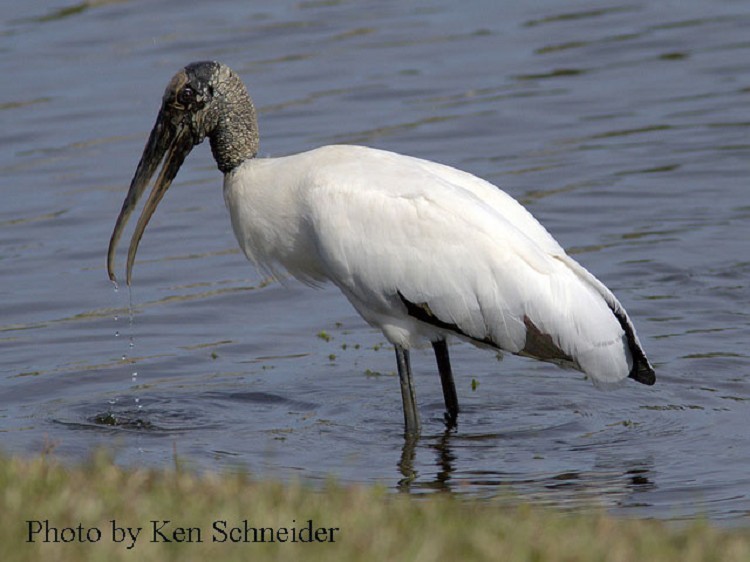Wood Stork, Mycteria americana

Large, long-legged, slow-moving, heavy wader that feeds in shallow water in southern wetlands and swamps, and is the only stork that breeds in the US. Often feeding in groups, the Wood Stork continuously moves his bill from side to side probing and feeling for food.
The population has been on the decline since the 1960s due to water management practices in South Florida and loss of habitat the Everglades. Wood Storks typically only occur in Tennessee from mid-July through September.
Description: Tall, dark, bald head and upper neck, all-white plumage, black iridescent wings, and tail feathers; a long, black, thick bill that is thicker at the base and slightly decurved.
Length: 40 inches
Wingspan: 61 inches
Weight: 5.3 lbs.
Voice: Usually silent, some hissing and bill clattering during nesting.
Similar Species:
- Egrets – Straight bill, feathered white head, no black markings on the wings.
- White Ibis – Much smaller, bright red face and bill, black on wings tips.
- Whooping Crane – Taller, shorter bill, red face, white head and less black in the wing. Whooping Cranes only occur in Tennessee in winter.
Habitat: In Tennessee, the Wood Stork can occasionally be found in wetlands and swamps in west Tennessee.
Diet: Crustaceans, frogs, lizards, rodents.
Nesting and reproduction: There are no known records of Wood Storks nesting in Tennessee.
Status in Tennessee: The Wood Stock is occasionally seen in marshes, shallow ponds, and mudflats in Tennessee.
Fun Facts:
- During breeding season Wood Storks toes turn pink.
- A Wood Stock can live 20-30 years.
Obsolete English Names: Ironhead, Flinthead, Pond Gannet
Best places to see in Tennessee: Ensley Bottoms, Mud Island State Park, Eagle Lake, and Reelfoot Lake in mid-July through September.
Sources:
Sibley, D. A. 2000. The Sibley Guide to Birds. A. A. Knopf, New York, NY.
Alsop, F.J, 2001, Birds of North America, DK Publishing, New York, NY
Peterson, R.T., 2002, Peterson Field Guide to Birds of North America, Houghton Mifflin, New York, New York
Coulter, M. C., J. A. Rodgers, J. C. Ogden and F. C. Depkin. 1999. Wood Stork (Mycteria americana), The Birds of North America Online (A. Poole, Ed.). Ithaca: Cornell Lab of Ornithology; Retrieved from the Birds of North America Online